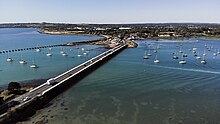

Langstone Bridge (also known as Hayling Bridge) connects Hayling Island with the English mainland of Hampshire.
The name of the bridge is derived from its location at the coastal village of Langstone.
Historically connection was by a causeway known as the Wadeway, this was severed by the construction of the Portsmouth and Arundel Canal.
Wadeway
The Wadeway or Wade Way is an original and historic causeway to Hayling Island, however it is now completely impassable, having been cut in two by a deep channel for the Portsmouth and Chichester Canal in the 1820s. It was classified as a bridleway in 1988, and is shown as such on modern Ordnance Survey maps in spite of its use being considered hazardous at best. Excavation of this feature in 2006, constructed on a natural high point in the harbour, put its date in the Roman to medieval range but found no evidence to be more specific.
Wooden Bridge
The Canal Company funded a replacement wooden road bridge served by a toll-house situated at the northern end. There was a weight-limit and after WW2 only single-decker buses were allowed across and if they were carrying too many passengers some had to get out and walk, regardless of the weather, to reduce axle-weight. The old wooden bridge was demolished following construction of a concrete bridge in the late 1950s.
The 1956 Bridge
A replacement concrete bridge opened in 1956, initially still as a toll bridge. The new bridge is owned by Hampshire County Council and was operated without tolls from April 1960. The construction work on the new bridge was carried out by Christiani and Nielsen.
Railway Bridge
A railway bridge was constructed for the Hayling Island branch line in the 1860s. This became disused after the railway's closure and the remains can be viewed to the west of the current bridge today
References
- Gladwyn, Derek (1992). Leigh Park a 19th Century Pleasure Ground. Middleton press. p. 44. ISBN 1-873793-07-3.
- "OPENING of HAYLING BRIDGE and CAUSEWAY" (PDF). Morning Post. 13 September 1824. Retrieved 12 April 2017.
- Langstone - Wadeway Investigation Archived 28 September 2013 at the Wayback Machine
- Hampshire County Council Rights of Way Sub-Committee Minutes, 14 Jan 1988, ITEM 3(b)"Accessed 25 Nov 2009"
- Chichester Harbour Conservancy "Changing Landscapes" project website "Accessed 25 Nov 2009" Citing unpublished reports by Maritime Archaeology Ltd, 2005, 2006, 2007 Chichester Wadeway Investigation Phases 1, 2, 3 respectively.
- "Hayling Billy". Archived from the original on 8 November 2010. Retrieved 10 October 2010.
- ^ Bridges in Hampshire of Historic Interest. Hampshire County Council. 2000. p. 51. ISBN 1859753469.
- "The Hayling Bridge and Wadeway (also known as Langstone Bridge)" (PDF). "The Spring Heritage and Arts (Havant). Retrieved 16 April 2016.
50°50.071′N 00°58.709′W / 50.834517°N 0.978483°W / 50.834517; -0.978483
This article about a Hampshire building or structure is a stub. You can help Misplaced Pages by expanding it. |
This article about a bridge in the United Kingdom is a stub. You can help Misplaced Pages by expanding it. |